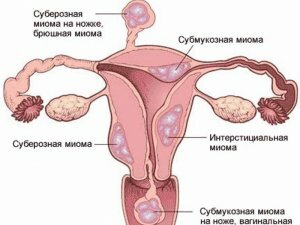Symptoms of uterine myoma
 Often the uterine myoma begins to develop at the age of about 30 years, but no manifestations of uterine fibroids may be present for quite a long time. The manifestations and symptoms of uterine fibroids depend on where the myomatous node is located, its size and the rate of growth of the myoma. The primary symptoms of uterine fibroids in many women appear in 35-40 years, which directly depends on reducing the production of sex hormones by the ovaries.
Often the uterine myoma begins to develop at the age of about 30 years, but no manifestations of uterine fibroids may be present for quite a long time. The manifestations and symptoms of uterine fibroids depend on where the myomatous node is located, its size and the rate of growth of the myoma. The primary symptoms of uterine fibroids in many women appear in 35-40 years, which directly depends on reducing the production of sex hormones by the ovaries.
Common symptoms of uterine fibroids
Menstrual flow increases
This is called menorrhagia. Bleeding becomes plentiful, which is taken for granted and women do not go to the doctor. Menorrhagia is dangerous because after a while it can lead to anemia. When the discharge becomes more abundant, this indicates that the muscles of the uterus have become worse to contract and medical care is required.
 With menorrhagia, another worrying symptom of this disease may appear: acyclic uterine bleeding( metrorrhagia).In this case, not the tumor, but the uterine mucosa bleeds, which is irritated by the presence of the tumor.
With menorrhagia, another worrying symptom of this disease may appear: acyclic uterine bleeding( metrorrhagia).In this case, not the tumor, but the uterine mucosa bleeds, which is irritated by the presence of the tumor.
Painful sensations
Along with hemorrhages with uterine myomas can be pain syndrome, the pain may be different. Usually the pain is localized in the lower abdomen and lower back. Pain is of a sudden sudden nature if the disease reaches the myoma( myoma node), where the blood circulation is disturbed. If the tumor is large and slowly increases, then during the menstrual cycle, the pain is aching. If the pain is cramping, it means that the tumor grows in the mucous membrane of the uterus. The pain does not appear immediately, but after a certain time of the disease, at first the myomas are almost painless.
Disruption of the functioning of neighboring organs
One of the symptoms of fibroids is disruption of the work of neighboring organs, this refers to the work of the bladder and rectum in the first place. If the myoma grows in their direction, then in these organs there is a feeling of depression. Therefore, there are problems with urination, it is more frequent, but difficult. Often there are chronic constipation, when myoma presses and squeezes the rectum. If there are such primary signs, then it is necessary to go to the doctor, but not only to the urologist or gastroenterologist, but also to the gynecologist, to exclude myoma of the uterus. Usually a good urologist himself sends a woman to a gynecologist.
Cardiovascular system
Myoma of the uterus is associated with the cardiovascular system. Often, when a tumor develops, a woman experiences pain in the region of the heart, the tone of the heart muscle decreases. In severe cases, venous pressure increases, which is very unfavorable for women who have hypertension or heart failure. In this case it is necessary to visit the cardiologist and necessarily the gynecologist, it will help to avoid serious problems with health.
Anemia
With myomas, anemia can occur. This decrease in hemoglobin and erythrocytes in the blood because of heavy bleeding. Anemia is expressed with uterine myoma with a constant headache, dizziness, pallor and weakness.
Myoma of the uterus is also asymptomatic( usually at an early stage of the disease).

